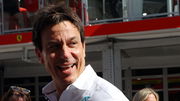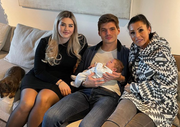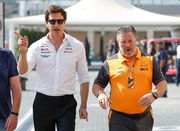
Getty
A portrait of Ayrton Senna of Brazil, driver of the #1 Honda Marlboro McLaren McLaren MP4/7A Honda V12 during tyre testing for the British Grand Prix on 7 July 1992 at the Silverstone Circuit in Towcester, Great Britain. (Photo by Mike Hewitt/Allsport/Getty Images)

Getty
A portrait of Ayrton Senna of Brazil, driver of the #1 Honda Marlboro McLaren McLaren MP4/7A Honda V12 during tyre testing for the British Grand Prix on 7 July 1992 at the Silverstone Circuit in Towcester, Great Britain. (Photo by Mike Hewitt/Allsport/Getty Images)
“If you no longer go for a gap, you’re no longer a racing driver.” These are perhaps some of the most apt words ever spoken by the legendary Ayrton Senna that capture the essence of his approach to racing – relentless, determined, and fearless. However, Senna’s impact on Formula 1 goes far beyond his victories and championships. His career revolved around his unwavering commitment to excellence, something that made him extremely strong-headed according to his and Michael Schumacher‘s former race engineer, and current F1’s Chief Technical Officer, Pat Symonds.
Watch What’s Trending Now!
When it came to pure skills, Senna’s driving prowess was unmatched, evident from his remarkable test run in 1983 when he outpaced the reigning World Champion, Keke Rosberg, while testing for Williams. However, there was one major weakness that plagued Ayrton Senna in his debut season. During a recent conversation on the ‘F1: Beyond The Grid’ podcast, Pat Symonds explained how Senna was physically unfit for racing, so much so that in his second race at Kyalami, he had to be pulled out of the car due to severe neck and shoulder cramps.
Ayrton Senna's qualifying lap for the 1993 South African Grand Prix at Kyalami.
Jesus!
What a lap! pic.twitter.com/kVHk5kGsoM
— Senna (@sennatheking) January 4, 2020
ADVERTISEMENT
Symonds also explained how Senna refused to accept that he had such weaknesses, which according to Symonds, was evidence of what he described as his ‘pigheaded’ nature. The podcast host, Tom Clarkson asked Symonds, “What was his [Ayrton Senna’s] standout quality in that first season?”
“The one thing that stood out that was on the other side of quality was his lack of fitness,“ said Symonds. “That was a real problem in his first year and he was very strong-minded and when we said look, ‘You can get faster if you were a bit fitter.’ At Kyalami, we had to lift him out of the car, because of his sort of strong almost pigheadedness, he wouldn’t accept things like that. But that same quality when it came to anything else, really drove him. So, you know, he’d say, oh the car’s doing this, oh the car’s doing that or I need this or I need that. And when you say that he listened because he knew what he was talking about.”
ADVERTISEMENT
ADVERTISEMENT
At the time, Formula 1 cars were considered to be extremely difficult to drive, according to Senna’s former fitness coach. Is it still the same?
Formula 1 cars are much easier to drive compared to the era of Ayrton Senna
Compared to the old days, drivers nowadays often cross the finish line feeling pretty good. Back in the day, though, things were different. The 1991 Brazilian Grand Prix is evidence of just how grueling Formula 1 used to be. It was a race in which Ayrton Senna pushed through muscle cramps, emotional stress, gearbox issues, and a torrential downpour, to secure a victory on his home soil.
ADVERTISEMENT
While Senna won the race, it came at a great cost, even after having worked extensively on his fitness since his debut season, he was so drained after the race that he needed help getting out of his car. Josef Leberer, the man responsible for keeping Senna in top shape back then, explains how F1 has evolved since those days. According to Leberer, today’s drivers don’t face anywhere near the same physical challenges as Senna did. “What happened that day is far away from where we are now,” Leberer told Autosport. “From the physical point of view, it has never been easier than now.”
Ayrton Senna overcomes the odds for an emotional home win at the 1991 Brazil Grand Prix.#sennasempre #ayrtonsenna #sennachampion #ayrton #senna #sennasempre #sennaeterno #ayrtonsennasempre #f1 #formula1 #formulaone #formulauno pic.twitter.com/4ct3pXDM2r
— Acelera Ayrton Oficial (@AceleraAyrton) August 30, 2019
He believes that the ease with which modern drivers finish races is more a testament to advancements in car technology than to any significant increase in fitness levels among the drivers themselves. “It is much easier to drive the car now. The guys can come from kindergarten now and they can drive the car,“ he added. That’s quite a statement!
ADVERTISEMENT
Do you agree that it’s just the cars that have become easier to drive? Or the drivers today are much more fit and conscious about their physical and mental well-being? Share your thoughts on the matter in the comments down below.
Top Stories
F1 Teams Protest as Toto Wolff’s Mercedes Given Clean Chit Over ‘Illegal’ Engine

Max Verstappen’s Siblings: Everything We Know About Victoria, Blue Jaye, Jason Jaxx, and Mila Faye

“Not Speaking to Anyone” – ‘Broken’ Lewis Hamilton Cuts All Ties With F1 World After Humiliating Season

Who Are Lando Norris’s Parents? Meet Adam Norris and Cisca Wauman

Zak Brown & McLaren Possibly in Deep Trouble as Mercedes Cuts Engine Supply for F1 2026

ADVERTISEMENT
ADVERTISEMENT
ADVERTISEMENT

